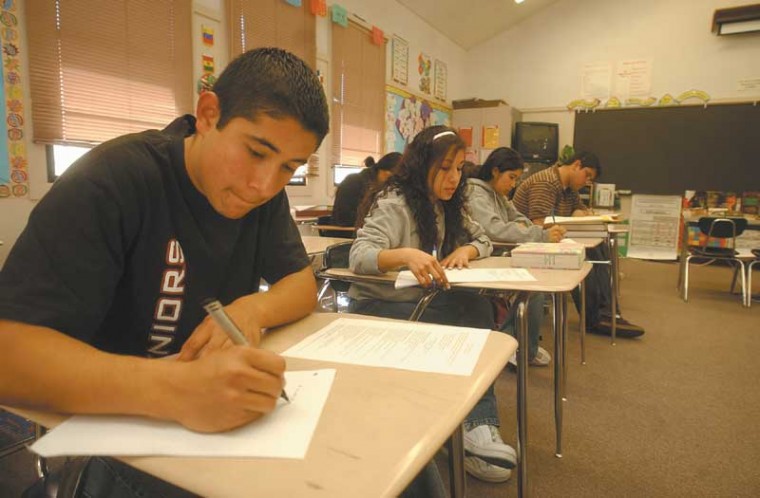
Hollister
– Christian Mercado knew long ago that he wanted to go to
college and he knew he would do whatever it took to get there.
Hollister – Christian Mercado knew long ago that he wanted to go to college and he knew he would do whatever it took to get there.
But during Mercado’s freshman year at San Benito High School, he realized he didn’t know what it would take to get into college.
He didn’t know the classes he needed, the tests he would have to take or how he would pay for his education. Mercado’s parents, who moved to the United States from Mexico when they were young and never attended college, knew little more than he did.
Mercado is not alone in facing barriers as a college-bound Hispanic student.
A new study led by a professor at the University of Oregon concluded that Hispanic students see themselves as facing more roadblocks in attending college than white students. This study has significant implications at San Benito High School, where 55 percent of the student population, like Mercado, is Hispanic.
Despite the roadblocks, Mercado is still determined to pursue a college degree.
“If you put it in your mind that you’re going to go to college, you’ll go. You might have to work harder, but you’ll go,” he said.
Now a senior at SBHS, Mercado has been accepted to three state universities, and is waiting to hear back from more.
Mercado’s journey toward college has not been easy, and he acknowledges he hasn’t overcome all of the barriers yet. But programs at the high school have helped facilitate the process for him and other Hispanic students.
The study on barriers to college for Hispanic students was performed by Ellen McWhirter, a professor at the UO School of Education. It emphasized the importance of programs that reach out to Latino students and families.
The study found that only 10 percent of the Hispanic students involved with the study got a degree, compared with 34 percent of the white students involved. This was true despite equal aspirations to attend college. More than 400 students participated in the study.
It’s difficult to tell if this statistic is echoed at SBHS, because college attendance is not tracked after high school. But in 2005, 49 percent of white students at SBHS had completed the requirements to attend a University of California or California State University school, while 31 percent of Hispanic students had met the requirements, according to the California Department of Education.
“The percentage of students who graduate with credit to attend CSU or UC schools is disproportionately white. It is something that needs to addressed,” said Stan Rose, superintendent of San Benito High School District.
The study found that Hispanic students also anticipated more roadblocks to attending college, which, McWhirter said, can be detrimental to their success.
“Those who perceived more barriers will be less likely to turn their career interests into goals and their goals into outcomes,” McWhirter wrote in the report on her study.
But despite an awareness of the barriers for Hispanic students at SBHS, many of these students are working harder to overcome these barriers.
“There are obstacles people face, but it’s all worth it on the way to college,” said Mercado.
Rose said many of the roadblocks have to do with communication between families and schools. He said the SBHS has programs in place to help bridge barriers between the families and schools.
The California Student Opportunity and Access Program, run by the state, and the migrant program, run by the school, both are designed to make college information more accessible to parents.
The migrant program gets parents involved and informed, teaching them, for example, what a grade point average is, and the importance of the SATs.
The access program provides informational nights about financial aid for parents in Spanish. Providing information to parents can help eliminate barriers, because the parent can offer their support.
But some of the lack of parent support can come from cultural differences, which is addressed as one of the biggest barriers in the study.
Domasio Zepeda, who is also a senior at SBHS, said his parents don’t really understand the American culture of education. Zepeda will be the first of his family to graduate from high school. His father never attended school and his mother went only through third grade.
“My mom supports me (in wanting to attend college), but my dad wants me to stay home,” said Zepeda. “They’re not exposed to what we live now. My dad is stuck back in his period.”
Despite the barriers that exist, administrators at SBHS are working to make college more accessible to all students, including Hispanics.
“This has nothing to do with intelligence,” Rose said. “It has to do with access.”
Alice Joy covers education for the Free Lance. You can reach her at (831) 637-5566 ext. 336 or at aj**@***********ws.com. The Associated Press contributed to this report.









